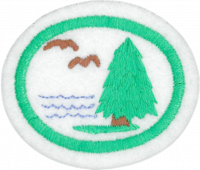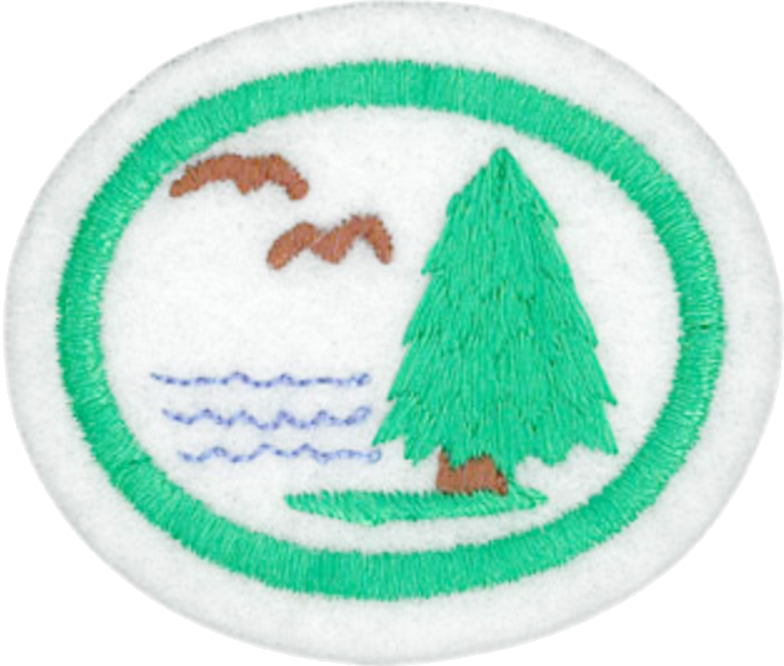Difference between revisions of "AY Honors/Ecology/Requirements"
Jomegat bot (talk | contribs) m (Jomegat bot moved page AY Honor Ecology Requirements to AY Honor Ecology Requirements: Bot: Moved page) |
m |
||
| (7 intermediate revisions by 2 users not shown) | |||
| Line 1: | Line 1: | ||
| − | + | {{HonorSubpage}} | |
| − | |||
| − | |||
| − | + | <section begin=Body /> | |
| − | |||
| − | <b> | + | <b>1. <section begin=req1 /><noinclude><translate><!--T:1--> |
| − | <section end= | + | </noinclude>Construct a diagram of a fresh-water pond ecosystem with pasted-on animal cutouts. |
| + | <noinclude></translate></noinclude><section end=req1 /></b> | ||
| − | <b> | + | <b>2. <section begin=req2 /><noinclude><translate><!--T:2--> |
| − | < | + | </noinclude>Pick one mammal, bird, reptile, and amphibian from your home environment, and for each construct a diagram of its ecological pyramid. |
| + | <noinclude></translate></noinclude><section end=req2 /></b> | ||
| − | + | <b>3. <section begin=req3 /><noinclude><translate><!--T:3--> | |
| − | < | + | </noinclude>Know the meaning of the following terms: |
| + | <noinclude></translate></noinclude><section end=req3 /></b> | ||
| − | :<b> | + | :<b>a. <section begin=req3a /><noinclude><translate><!--T:4--> |
| − | < | + | </noinclude>Ecology |
| + | <noinclude></translate></noinclude><section end=req3a /></b> | ||
| − | :<b> | + | :<b>b. <section begin=req3b /><noinclude><translate><!--T:5--> |
| − | < | + | </noinclude>Community |
| + | <noinclude></translate></noinclude><section end=req3b /></b> | ||
| − | :<b> | + | :<b>c. <section begin=req3c /><noinclude><translate><!--T:6--> |
| − | < | + | </noinclude>Food chain |
| + | <noinclude></translate></noinclude><section end=req3c /></b> | ||
| − | :<b> | + | :<b>d. <section begin=req3d /><noinclude><translate><!--T:7--> |
| − | < | + | </noinclude>Commensalism |
| + | <noinclude></translate></noinclude><section end=req3d /></b> | ||
| − | :<b> | + | :<b>e. <section begin=req3e /><noinclude><translate><!--T:8--> |
| − | < | + | </noinclude>Ecological succession |
| + | <noinclude></translate></noinclude><section end=req3e /></b> | ||
| − | :<b> | + | :<b>f. <section begin=req3f /><noinclude><translate><!--T:9--> |
| − | < | + | </noinclude>Plankton |
| + | <noinclude></translate></noinclude><section end=req3f /></b> | ||
| − | :<b> | + | :<b>g. <section begin=req3g /><noinclude><translate><!--T:10--> |
| − | < | + | </noinclude>Conservation |
| + | <noinclude></translate></noinclude><section end=req3g /></b> | ||
| − | :<b> | + | :<b>h. <section begin=req3h /><noinclude><translate><!--T:11--> |
| − | < | + | </noinclude>Climax community |
| + | <noinclude></translate></noinclude><section end=req3h /></b> | ||
| − | :<b> | + | :<b>i. <section begin=req3i /><noinclude><translate><!--T:12--> |
| − | < | + | </noinclude>Eutrophication |
| + | <noinclude></translate></noinclude><section end=req3i /></b> | ||
| − | <b> | + | :<b>j. <section begin=req3j /><noinclude><translate><!--T:13--> |
| − | < | + | </noinclude>Biome |
| + | <noinclude></translate></noinclude><section end=req3j /></b> | ||
| − | <b> | + | <section begin=challenge /> |
| − | <section end= | + | <b>4. <section begin=req4 /><noinclude><translate><!--T:14--> |
| + | </noinclude>Make detailed field observations and a careful library book study of the habitat of some small animal in your own environment. Write a report of about 700 words, one-half from your field observations and one-half from your book study. | ||
| + | <noinclude></translate></noinclude><section end=req4 /></b> | ||
| + | <section end=challenge /> | ||
| − | <b> | + | <b>5. <section begin=req5 /><noinclude><translate><!--T:15--> |
| − | <section end= | + | </noinclude>Define an ecosystem and state what the basic biological and physical factors are that keep it a balanced system. |
| + | <noinclude></translate></noinclude><section end=req5 /></b> | ||
| − | <b> | + | <b>6. <section begin=req6 /><noinclude><translate><!--T:16--> |
| − | <section end= | + | </noinclude>Investigate the disposal of trash in your community. How much is disposed per family per day? per week? per year? How better can it be taken care of? |
| + | <noinclude></translate></noinclude><section end=req6 /></b> | ||
| − | <b> | + | <b>7. <section begin=req7 /><noinclude><translate><!--T:17--> |
| − | <section end= | + | </noinclude>Check the daily paper for one month for the nearest large city for the air pollution level or air quality and plot on graph paper the results for the month. Find out what caused the peaks on your graph. |
| + | <noinclude></translate></noinclude><section end=req7 /></b> | ||
| − | <b> | + | <b>8. <section begin=req8 /><noinclude><translate><!--T:18--> |
| − | <section end= | + | </noinclude>List ten ways in which you might actively work to improve the environment in which you live. Put four of these into practice. |
| + | <noinclude></translate></noinclude><section end=req8 /></b> | ||
| − | + | <b>9. <section begin=req9 /><noinclude><translate><!--T:19--> | |
| − | + | </noinclude>Find a Spirit of Prophecy quotation and a Bible text pertinent to ecology, and be able to explain their relevance and application to our day. | |
| + | <noinclude></translate></noinclude><section end=req9 /></b> | ||
| + | <section end=Body /> | ||
Latest revision as of 01:36, 4 January 2023
1. Construct a diagram of a fresh-water pond ecosystem with pasted-on animal cutouts.
2. Pick one mammal, bird, reptile, and amphibian from your home environment, and for each construct a diagram of its ecological pyramid.
3. Know the meaning of the following terms:
- a. Ecology
- b. Community
- c. Food chain
- d. Commensalism
- e. Ecological succession
- f. Plankton
- g. Conservation
- h. Climax community
- i. Eutrophication
- j. Biome
4. Make detailed field observations and a careful library book study of the habitat of some small animal in your own environment. Write a report of about 700 words, one-half from your field observations and one-half from your book study.
5. Define an ecosystem and state what the basic biological and physical factors are that keep it a balanced system.
6. Investigate the disposal of trash in your community. How much is disposed per family per day? per week? per year? How better can it be taken care of?
7. Check the daily paper for one month for the nearest large city for the air pollution level or air quality and plot on graph paper the results for the month. Find out what caused the peaks on your graph.
8. List ten ways in which you might actively work to improve the environment in which you live. Put four of these into practice.
9. Find a Spirit of Prophecy quotation and a Bible text pertinent to ecology, and be able to explain their relevance and application to our day.


